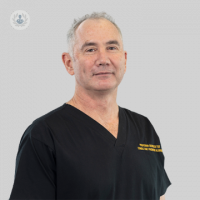When is urticaria serious?
Written by:Urticaria, also known as hives, is common in childhood. Allergic hives are usually short lived, but allergic reactions can be severe (anaphylaxis). Hives that arise due to an infection can persist for many days and will go away on its own. In rare cases, urticaria can be chronic (lasting longer than 6 weeks), and more specialist treatment might be necessary.
In this article, paediatric allergist Professor George Du Toit gives an overview of the different types of urticaria, what to expect, and what treatment looks like. The terms urticaria/hives/wheals are used interchangeably.

Allergic hives
The commonest cause of urticaria is a food allergy, where the child typically develops skin rashes and hives after eating an allergic food. Given the obvious causality between symptoms and food ingestion and the rapid onset of symptoms, this is generally an easy diagnosis to make. The child will often dislike food and is unlikely to eat it on recurrent occasions. Hives that arise due to a food allergy are usually short lived (hours) and associated with other allergy symptoms such as behavioural change, vomiting, gut pain, or intra-oral symptoms such as a tickly throat.
Non-allergic hives
Children may develop hives after an infection. The child may not be that unwell at the time of the causal infection which may have been something as simple as a seasonal cold and are seldom unwell when the hives first begin. Whilst these hives are often very angry-looking and make the child uncomfortable as they are extremely itchy, children come to no harm, as they are not associated in any way with severe allergic reactions. Antihistamines are only partially successful at providing total symptom control. The hives, which may be large and generalised in distribution, will resolve on their own. There is no need for treatment of the underlying infection if the child is otherwise well.
Spontaneous Chronic urticaria (CU)
Chronic urticaria is where the hives persist for at least six weeks, and is more troubling.
In CU the hives are flitting and will wax and wane in intensity and, in children, are usually associated with angioedema (swelling of the lips or eyelids).
CU is generally considered an autoimmune condition, where the body raises antibodies against the cells that release histamine in the skin and mucosal tissues (mast cells and basophils). CU is more difficult to treat and high-dose antihistamines will frequently be required. If they’re not sufficient, then in specialist care setting, more advanced add-on medications can be recommended. Food allergy is seldom ever a cause of CU. It may take many years before CU is spontaneously outgrown.
Physical urticaria
There are many physical triggers for chronic urticaria. These triggers can be cold, vibration, or pressure-induced. For example, where a child is held firmly, their skin may develop hives, or scratch marks may induce linear streaks (known as dermatographism). In cold urticaria hives will come on in exposed areas, particularly after rapid temperature fluxes. Heat may also do this, as may ultraviolet light. This is known as solar urticaria. It is very rare for other triggers such as water to cause inducible hives, but there are conditions known as aquagenic urticaria. In older children at the time of exercise they may develop a variant of hives known as cholinergic urticaria. Children with CU usually have hives that are exacerbated by one or more physical triggers.
The goal of therapy in chronic urticaria is to treat the disease until all symptoms remit – with as few side effects of the treatment as possible.


